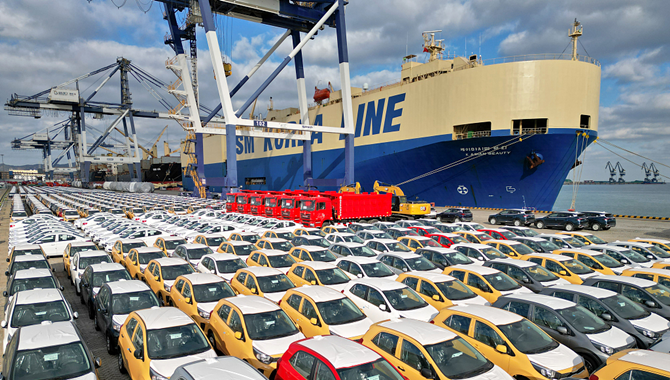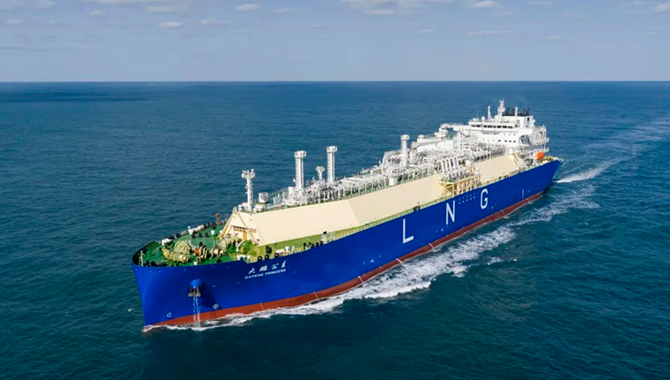
Vehicles wait to be loaded on the pure car and truck carriers in the Yantan Port, east China's Shandong Province, December 11, 2022. /CFP
Chinese shipbuilders won all 17 new orders for pure car and truck carriers (PCTC) worldwide in January.
This may not sound impressive upon first hearing it, but there were only four PCTCs traded annually on average from 2016 to 2020.
In recent years, the demand for and construction of PCTC have been bolstered by China's booming car exports and shipowners' demand for replacement.
Tailwind of car exports
China's automobile exports exceeded 2 million for the first time in 2021 and continued to top over 3 million units in 2022, rising by 54.4 percent year on year. New energy vehicle (NEV) exports recorded a year-on-year increase of 1.2 times to 679,000, data from the China Association of Automobile Manufactures showed.
According to UK-based Clarkson Research, the 17 new orders for PCTC totaled a combined 510,000 deadweight tonnes with 152,000 parking spots.
Amid growing exports, domestic car manufacturers, such as BYD Auto and SAIC Motor, have also started making their own transportation plans, Zhang Zhuo, a leading expert from Shanghai Merchant Ship Design and Research Institute told China Media Group.
NEVs are relatively heavier due to their batteries on top of more enlarged passenger car models, he said, adding the car carriers should establish a larger deck to transport more vehicles.
Plan ahead
Most of the ships on the market between 2016-2020 were over 20 years old and could not meet the new shipping regulations, which means the shipowners' demand for replacement was about to surge.
China's largest shipbuilder, China State Shipbuilding Corporation Limited (CSSC), foresaw the market opportunity and decided to make strategic moves.
Since the CSSC rolled out large-scale PCTC models in 2021, it has won 32 orders for vessels with car-carrying capacities of 7,000 to 9,200, accounting for 25 percent of the global market share, according to the corporation.
Eighty new PCTC orders were inked globally in 2022, of which 47 orders were designed by Shanghai Merchant Ship Design and Research Institute, the design arm of the CSSC.
The institute also launched the world's largest 9,400-unit dual-fuel PCTC, which is developed with independent intellectual property rights, and China's first 7,000-unit ammonia fuel-powered PCTC.

The Dapeng Princess LNG carrier is delivered in east China's Shanghai, February 18, 2023. /CFP
Beyond car carriers
Despite a gloomy global market, China retained the largest share of the global shipbuilding market for the 13th straight year in 2022, with six companies ranking among the world's top 10 shipbuilding enterprises.
Besides PCTC, the CSSC received 49 LNG carrier orders in 2022, with the combined contract value topping $10 billion. These vessels, tank ships designed for transporting liquefied natural gas, made up 30 percent of the global LNG orders, up from less than 7 percent in 2021, hitting a record high.
Substantial headway has also been made in the production of the large cruise ship, which is one of the most complex vessels to design and build. In August, China started the construction of its second domestically built large cruise ship, with work on the first one underway as scheduled.
Official data showed that China's shipbuilders were on top in three major indicators last year globally, contributing 47.3 percent of global output, receiving 55.2 percent of new orders, and obtaining 49 percent of holding orders.
Source: Xinhua
The opinions expressed herein are the author's and not necessarily those of The Xinde Marine News.
Please Contact Us at:
media@xindemarine.com



 Ningbo Containerized Freight Index Weekly Commentar
Ningbo Containerized Freight Index Weekly Commentar  Ningbo Containerized Freight Index Weekly Commentar
Ningbo Containerized Freight Index Weekly Commentar  Ningbo Containerized Freight Index Weekly Commentar
Ningbo Containerized Freight Index Weekly Commentar  BIMCO Shipping Number of the Week: Bulker newbuildi
BIMCO Shipping Number of the Week: Bulker newbuildi  Ningbo Containerized Freight Index Weekly Commentar
Ningbo Containerized Freight Index Weekly Commentar  Ningbo Containerized Freight Index Weekly Commentar
Ningbo Containerized Freight Index Weekly Commentar